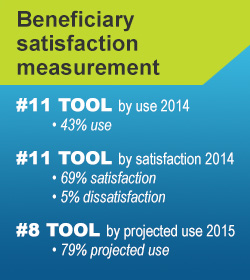Beneficiary satisfaction measurement refers to the process of thoughtfully and proactively soliciting feedback from parties that derive benefits from a particular program—most importantly the direct service recipients—on how well a nonprofit's programs met their needs and expectations, and using this input to strengthen services and increase impact. Beneficiary satisfaction measurement enables beneficiaries to make their voices heard, and provides nonprofits with an opportunity to learn from those who care deeply about the value of a program or service and then to take action.
How it's used
Although the ultimate purpose of beneficiary satisfaction measurement is to strengthen a nonprofit's programs, services, and operations, and to increase its impact, there also are many specific uses, including determining the success of a particular program or providing beneficiary input into developing or adapting programs. More detailed beneficiary satisfaction measurement can also help to identify specific strengths and weaknesses of a program or service. Key information is usually gathered through surveys, purposeful conversations, or focus groups. These processes are most effective when implemented as part of a standardized, well-integrated system in which the organization has clearly determined the objectives, information desired, processes for collecting and analyzing data, and methods for reporting results and assessing the implications of any actions—and is fully committed to executing these processes regularly.
Methodology
Beneficiary satisfaction measurement may be a component of or input into an organization's ongoing performance measurement and improvement, program evaluation, or constituent engagement practices. It can be collected periodically (e.g., once a year), or performed on an ongoing basis (e.g., after every visit), but the process is generally similar.
- Determine the purpose: Set the goal of and agenda for measurement, i.e., whether to get general feedback for performance measurement or to help inform a specific decision.
- Decide on scope: Working from the defined purpose of measurement, determine the specific questions to be investigated and the level of detail that must be discerned. Once those parameters are established, decide which platform(s) or tool(s) would be most useful (focus groups, surveys, etc.) and find the right frequency and timing.
- Gather feedback: Begin implementing the plan for gathering input from beneficiaries. Ensure that the participants reflect the diversity of the program beneficiaries in all relevant categories (e.g., age, income, gender). Make extra effort to include the perspectives of beneficiaries that might be harder to reach (e.g., less tech-savvy, second-language speakers). Consider also soliciting the perspectives of program dropouts, individuals who fit the target beneficiary profile but have decided not to participate, or family members of participants.
- Measure and analyze results: Analyze feedback and generate relevant insights that could impact the organization's programs, services, processes, and decisions.
- Determine what changes need to be made, then develop and execute them.
Related topics
Additional resources
The Really Busy Person's Guide to Constituent Voice
Keystone Accountability's brief introduction to the why and how of seeking feedback from constituents.
Listening To Those Who Matter Most, the Beneficiaries
When seeking insights into how to become more effective, don't forget the voice of the beneficiary.
Examples and case studies
Get Feedback
This magazine article covers why it is essential to build direct consumer feedback into funding criteria for government and nonprofit programs serving low-income people.
Measures of Effective Teaching Project
This summary of a research project provides information about teacher evaluation systems, including the use of student surveys.
Measurement That Benefits the Measured
This blog post on three forms of engagement that can help nonprofits better respond to the needs and strengths of their constituents.


